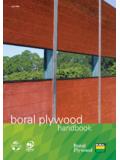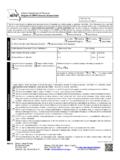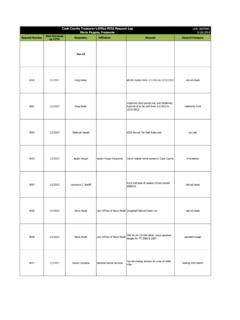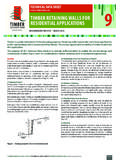Transcription of TQL 9 Timber Retaining Walls for Residential Applications
1 Timber Queensland Technical Data Sheet 9 - Timber Retaining WallsRevised March 2006 - Page 110 is a preferred material for landscaping purposes. Retainingwalls in particular contribute significantly to the surroundingswhen constructed in Timber . The natural appeal and versatility oftimber is ideal for this purpose of this Technical Data Sheet is to provide sufficientdetail to enable the correct design and construction of either logor sawn (or combinations) Timber Retaining Walls in document is intended to provide guidance for the designand construction of Timber Retaining Walls in Residential settingsand shall not be usedshall not be usedshall not be usedshall not be usedshall not be used where design or construction exceeds anyof the following limits or there is any variation to the limitations stated in this DataSheet including materials, soil conditions, drainage, surcharge(additional loads) or geometry of the Retaining wall, a structural/geotechnical engineer should be engaged to design the wall.
2 (i)(i)(i)(i)(i)Sloping GroundSloping GroundSloping GroundSloping GroundSloping GroundIf the ground in front of the wall is sloping then full groundsupport cannot be relied upon and larger posts with additionalembedment will have to be used. If the slope is steeper than 10 (1 vertical to 6 horizontal) then a special design is required, andthe tables herein shall not be used. (See Figure 1)Inclining the ground behind the wall (backfill) produces morevertical load due to weight of backfill. This results in higherhorizontal loads (horizontal loads deriving from vertical loads).If the ground behind the wall (backfill) has a slope steeper than14 (1 vertical to 4 horizontal) the design tables are not applicabledue to resulting higher gravity and live loads that will exceed thedesign loads assumed for the 1 - Sloping ground in front of and behind wallFigure 1 - Sloping ground in front of and behind wallFigure 1 - Sloping ground in front of and behind wallFigure 1 - Sloping ground in front of and behind wallFigure 1 - Sloping ground in front of and behind wall(ii)(ii)(ii)(ii)(ii)Permanent Structures (Existing or future)Permanent Structures (Existing or future)Permanent Structures (Existing or future)Permanent Structures (Existing or future)Permanent Structures (Existing or future)
3 The horizontal force generated by the vertical load of permanentstructures can have significant impact on the performance ofretaining structures. Permanent structures include (but are notlimited to); buildings, pools, roads, parking areas, water tanks,general storage. If any such structures will impact within the zoneof influence, as per Figure 3, the Retaining wall design should bereferred to a structural/geotechnical engineer. Fences oflightweight materials ( Timber , metal etc) constructed on or abovethe wall do not impact on the design of the Walls .(iii)(iii)(iii)(iii)(iii)Roads or RailwaysRoads or RailwaysRoads or RailwaysRoads or RailwaysRoads or RailwaysRoads and railways and areas adjacent are required to be designedfor loads to accommodate the infrastructure and the vehiclesover (trains, trucks etc).
4 These loads are significantly larger thanthose allowed for in this Data Sheet and therefore the Data Sheetshall not be used in these situations.(iv)(iv)(iv)(iv)(iv)Multiple Retaining StructuresMultiple Retaining StructuresMultiple Retaining StructuresMultiple Retaining StructuresMultiple Retaining StructuresA Retaining structure constructed within the zone of influence ofanother Retaining structure will apply additional loads to the lowerwall. TTTTT erraced Walls require specific design by structural /erraced Walls require specific design by structural /erraced Walls require specific design by structural /erraced Walls require specific design by structural /erraced Walls require specific design by structural /geotechnical enginners. This includes installing a new retainingwall above ororororor below an existing Retaining structure.
5 The attachedtables should not be used for designing any Retaining structurewith an existing or future Retaining structure above or below suchthat the upper wall impacts within the zone of influence of thelower, as per Figure 3.(v)(v)(v)(v)(v)ServicesServicesService sServicesServicesRetaining structures constructed in locations near services requireparticular mention. Generally the Walls are required to be designedto impart no load on the services. Additionally, local authoritieshave specific requirements for different types of services, includingminimum clearances. Retaining Walls to be constructed near servicelocations should be referred to the relevant local authority.(vi)(vi)(vi)(vi)(vi)DrainageDr ainageDrainageDrainageDrainageDrainage of both the localized wall area and the surroundingtopography should be considered during the planning investigations should establish the local groundwaterlevels including sources, directions of lateral flow and seasonal ortidal variations.
6 The possibility of seepage or surface run off shouldalso be examined. Inadequate drainage can result in overloadingof the wall or scouring of the footings, either of which may leadto wall failure. Where doubt exists, a structural/geotechnicalengineer should be consulted.(vii)(vii)(vii)(vii)(vii)Poor Foundation MaterialPoor Foundation MaterialPoor Foundation MaterialPoor Foundation MaterialPoor Foundation MaterialThe foundation material assumed in design for this Data Sheetand attached tables is Stiff Clay. Stiff Clay is unable to be is able to be indented only with strong downward pressure alternative foundation materials are: Weathered rock (eg Shale) Dense sand / gravelIf the foundation material is not within this range, the tables inthis Data Sheet shall not be used.(viii)(viii)(viii)(viii)(viii)Poor Backfill MaterialPoor Backfill MaterialPoor Backfill MaterialPoor Backfill MaterialPoor Backfill MaterialThe attached tables include three options for backfill are: Sand, Sandy gravel and materials may result in wall failure due to swelling ofbackfill or lack of drainage.
7 If the backfill material is not withinthe above range, the tables shall not be used. Alternative backfillmaterial should be referred to a structural/geotechnical Retaining Wallsfor Residential Applications Recommended Practice / March 2006 Recommended Practice / March 2006 Recommended Practice / March 2006 Recommended Practice / March 2006 Recommended Practice / March 2006 Issued by: Timber Queensland LimitedIssued by: Timber Queensland LimitedIssued by: Timber Queensland LimitedIssued by: Timber Queensland LimitedIssued by: Timber Queensland LimitedTechnical Data Sheet9 Page 2- Revised March 2006 Timber Queensland Technical Data Sheet 9 - Timber Retaining Walls (ix)(ix)(ix)(ix)(ix)Consequence of Structural FailureConsequence of Structural FailureConsequence of Structural FailureConsequence of Structural FailureConsequence of Structural FailureThe designs contained in this Data Sheet assume StructuralClassification 2 and 3 as per AS 4678, that is - Where failurewould result in moderate damage and loss of services for wallsover and Where failure would result in minimal damageand loss of access and where the wall height does not , for Walls under the proposed Retaining wall location has adjacent structures orfacilities with post disaster functions or failure of the wall mayresult in significant damage or risk of life.
8 A structural/geotechnicalengineer should be may be used in sawn sizes approximating landscapesleepers or as logs where the round forms may be blendedunobtrusively into the natural setting. In addition, proprietarytimber crib wall systems are also minimum stress grade for sawn Timber shall be F7 forsoftwood and F14 for the Retaining wall forms part of a landscape whereplants are encouraged to soften the harder elements ofconstruction. In this environment the possibility of insect andfungal attack is high. In-ground Durability Class 1 Timber speciesor Timber preservative treated to H5 should therefore be heartwood of naturally durable species (durability class 1)that are suitable for Retaining Walls include ironbark, grey gum,tallowwood, forest red gum and bloodwood.
9 These species arealso listed as being termite resistant in accordance with AS that the outer layers of the log (sapwood) are removedor preservative treated to H5, these timbers will performsatisfactorily for more than 25 have a wide sapwood band that can be made highlydurable with CCA, ACQ or copper azole preservative CCA treated softwoods have an expected service life of 50years or treatment shall be in accordance with AS that the maximum percentage of untreated heartwood insoftwoods (durability class 4) shall not exceed 20% at any 2 - Log and sleeper Retaining wallsFigure 2 - Log and sleeper Retaining wallsFigure 2 - Log and sleeper Retaining wallsFigure 2 - Log and sleeper Retaining wallsFigure 2 - Log and sleeper Retaining wallsFigure 3 - Stable zoneFigure 3 - Stable zoneFigure 3 - Stable zoneFigure 3 - Stable zoneFigure 3 - Stable zoneForcesRegardless of the construction material, it is worthwhile tounderstand the forces that have to be resisted so that they may bereduced to reasonable levels or allowed for in the wall vertical load of the soil, and whatever rests upon it, generatesa horizontal force that the wall must resist.
10 It follows that anyincrease in load must be allowed for at the design stage. Thiswould include future: increase in level or slope of the backfill. temporary loads such as dumped materials or heavy vehicles permanent structures such as building foundations orswimming pools (both in and above-ground)If a typical house foundation is located within the stable zone(shown shaded in Figure 3) then it is outside the zone of influenceand its presence will have a negligible effect on the stability of thewall. If this is the case, then the accompanying tables are valid, ifotherwise refer to a structural/geotechnical engineer for a specificdesign. Timber Queensland Technical Data Sheet 9 - Timber Retaining WallsRevised March 2006 - Page 3and possibly wall vertical layer of free draining material must be placed immediatelybehind the wall to dissipate the build-up of groundwater whichotherwise would add to the load carried by the structure.







